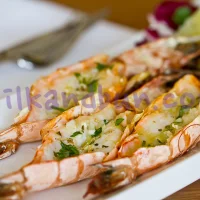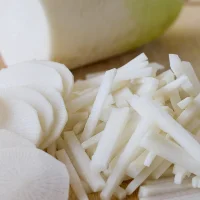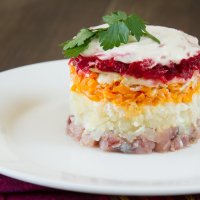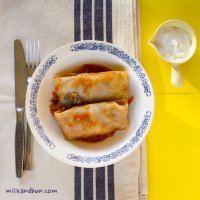Stuffed cabbage rolls is a very popular dish in many countries over the world. In Russia, it’s called ‘golubtsi’ – white cabbage leaves stuffed with sautéed ground pork or beef and rice or buckwheat.
Originally, cabbage leaves were stuffed with meat mixed with millet porridge and the dish was named ‘galushi’. But in 18-19th centuries France had a great influence on Russian cuisine, at least for the upper classes. Many French chefs streamed to Russian to work for royal courts, nobility and other wealthy families. 

French cooking was so prevalent among the upper classes that there were not enough French-born chefs to fill the demand. Wealthy Russians began to send their serfs to work under French chefs in Moscow and Sr.Petersburg, and a few were even sent to France for their training. Some of these peasants were allowed to work in the city, provided they remitted to their masters the required obrok or quit-rent, which was a payment in kind or in money. Others were sold after they had completed their training. Count Rostov in Tolstoy’s War and Peace, for instance, spoke with satisfaction of paying a thousand rubles for Taras, a serf who prepared savory hazel grouse sautéed in Madeira for his daughter Natasha’s name day dinner.*
Thus, Russians were hooked on French dishes, and among which was popular a whole grilled pigeon, covered with a cabbage leave. The dish became fancy and well-liked, and soon was called simply ‘golubi’ or ‘golubtsi’ – from Russian word ‘golub’ that literally means pigeon. Lately cooks began to prepare a fake ‘pigeon’ – well-known stuffed cabbage rolls, which were cheaper and affordable for the lower classes.
Also, big thanks to Angie for featuring my post – red pancakes! I’m bringing these cabbage rolls to the super Fiesta Friday party! I know, it’s such a simple dish, that many of you have tried it already, but I hope you are tired of sweets and enjoy Russian comforting food. 🙂
Golubtsi - Russian stuffed cabbage rolls
Ingredients
1 white cabbage
500g beef mince (or mix pork+beef)
90-100g uncooked white rice, short-grain
1/2 large onion, finely chopped
1/2 carrot, shredded
1/2 tsp dried marjoram, optional
S&P to taste
Sauce
1/2 large onion, chopped
1/2 carrot, shredded
2-3 tbsp tomato paste
oil, for frying
200-300ml water*
2 bay leaves
5-6 black peppercorns
S&P to taste
Garnish
sour cream, chopped parsley, optional
- Sauce. In a large pan over medium heat, heat the oil. Add onion and carrot for the sauce, cook for 5-6 minutes or until soft. Stir in tomato paste. Turn off the heat and set aside.
- Cabbage. Discard the 2 or 3 outer leaves of the cabbage. Carefully pull off leaves one by one. Bring a large pot of salted water to boil. Immerse cabbage leaves and cook for 3-4 minutes. Using tongs, take the leaves out and transfer to a bowl. *Reserve the water to use it lately for the sauce.
- Filling. Cook the rice fro 8-10 minutes in bowling water. In a large bowl, mix together the beef, rice, onion, carrot and spices. You can fry onion before adding it to the filling.
- Working with one cabbage leaf at a time, slice off the thick outer rib near the stem end. Place the leaf, rounded up like a bowl, stem end closest to you. Spoon about 2 tbsp of the meat mixture, form it into a short log shape. Don’t make the rolls too tight. Transfer the roll, seams down, to the pan with sauce. Shape the remaining rolls in the same way.
- Pour in water – just to cover the cabbage rolls, add more if needed. Season to taste, add bay leaves and peppercorns. On a medium-high heat bring it to boil. Then reduce heat to lower, cover the pan with a lid (or you can use a piece of foil) and cook for 40 minutes. You may cut one roll to test it.
- Serve rolls with their cooking sauce, sprinkled with parsley and garnish with sour cream, if desired.





























